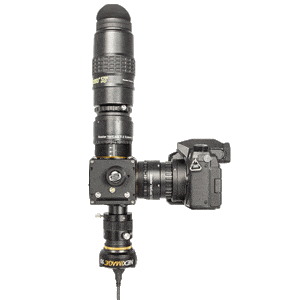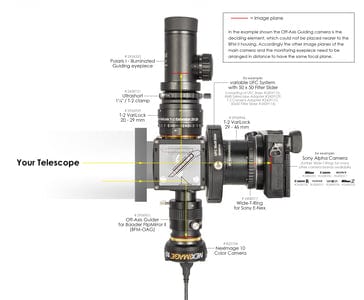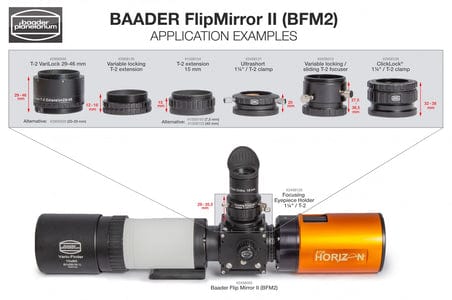Description
- Off Axis Guider (BFM-OAG) for direct connection to the Baader FlipMirror II Star Diagonal (#2458055, € 195,-)
- This is the only prism that can be tuned to actively center a star on the guiding chip.
- Use the BFM-OAG to attach an autoguider camera to a Baader FlipMirror II Mirror Diagonal that works with every position of the mirror.
- The distance between the optical axis and the center of the OAG prism is 17.5mm - once the 4mm spacer ring is removed. This distance provides the largest possible vignetting-free field while retaining all the advantages of the large and movable prism.
- With one or two DT-4 nosepiece extensions #1905130 you can place virtually any camera above the Off-Axis-Guider so that it is Par focal with the recording camera.
- The BFM-OAG is also part of the Off Axis Guider for RCC (RCC-OAG) #2956950
- Requires 24mm back focus on BFM II
This Off-Axis-Guider is made for the Baader FlipMirror II (BFM II) Mirror Diagonal #2458055. It connects to the bottom port of the BFM II (19 mm nosepiece) and sends light through a pickup-prism to an autoguider camera, independent of the position of the mirror. To attach the Off-Axis-Guider instead to a telescope without BFM II, you need the Off Axis Guider for RCC (RCC-OAG) # 2956950 with T-2-threads.
You can attach the Off-Axis-Guider for Baader FlipMirror II (BFM-OAG) directly to the Baader FlipMirror II Mirror Diagonal. You only have to remove the small spacer ring which is included as shown in the image to the left, so that the prism is fully inserted into the light path of the BFM II.
The distance between the optical axis and the center of the OAG prism is 17.5mm - once the 4mm spacer ring is removed. This distance provides the largest possible vignetting-free field while retaining all the advantages of the large and movable prism. This information is important, among other things, to be able to estimate or avoid vignetting of the camera sensor.
If the prism would protrude too far into the light path, the 4mm spacer ring can be inserted. However, this reduces the usable area of the prism, and thus also the amount of light that can be used for tracking.
Please note: this is the only prism that can be tuned to actively center a star on the guiding chip. The vertical side of the prism must face the telescope.
The BFM-OAG is also part of the Off Axis Guider for RCC (RCC-OAG) # 2956950. To use this item with the BFM II, you need to remove the unit with the pick-up prism from the T-2-ring and the spacer ring from the pick-up prism exactly as with the Off-Axis-Guider for BFM II.

The prism is always below the mirror so that it can also be used when the mirror is down, e.g. to guide a planetary camera connected to the upper port. When the mirror is up, the camera at the rear port should be aligned in such a way that the prism is under the long side of the sensor.
You have several options to set the guiding camera to the same focus plane as the cameras/eyepieces which are connected to main light path of the FlipMirror. You can use the usual combinations of T-2 or M48 extensions tubes to change the position of camera/eyepieces. If you need to bring the autoguider further away from the BFM II, you can extend the 1¼" nosepiece of your autoguider with one or two DT-4-nosepiece extensions #1905130 and lock the position with the Focusing Ring Collar FR-4 #1905131.
If you are using an Off-Axis Guider, you must also consider the focus position of the guiding camera. If you use the Off-Axis-Guider for Baader FlipMirror II as well as a guiding camera whose image plane is at the upper end of the Off-Axis-Guider (i.e. without additional back focus), the image plane of the camera and eyepiece is about 24mm behind the two T-2 threads of the BFM II. A CCD camera with a short back focus, for example, can be adjusted to this distance with a VariLock 29, as can the Polaris I crosshair eyepiece when connected directly to the VariLock 29 via T-2. Thus, a very short adaptation is possible.
If you use a DSLR via a T-2 adapter, or an eyepiece clamp for the eyepiece, you need more back focus. Then, the guiding camera must be placed at a greater distance from the BFM II. The easiest way to do this is to use the DT-4 nosepiece extension #1905130 with an overall length of 18.5mm. It has the diameter of "1¼" eyepieces and is screwed into the "1¼" filter thread of the guiding camera. With one or two of these extensions, you can place virtually any camera over the off-axis guide so that it is Par focal with the recording camera.



























